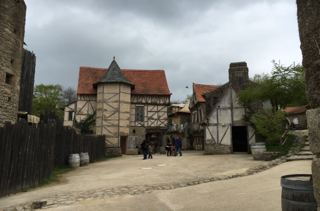Unlike most theme parks, there's no rides (apart from one train to get you around). Instead, there's shows: six Grand Spectacles and nine minor ones, scattered throughout the day, each depicting this region of the Vendee in a different era. We walked through the Village in 1900, a slightly Disney-esque reconstruction of a town square at the turn of the century (but a bit more real-looking because the buildings seemed authentic rather than just plastic facades) to get to the next show starting, the Secret of the Spear, a medieval extravaganza. We took our seats in the wooden stand, facing a sand-covered corridor with a castle wall and battlements behind, not sure what to expect: some sort of staid re-enactment maybe. Instead we had stunt riding, jousting, a fantastical tale of a magic spear, moving battlements, accurate reconstructions of siege weapons and methodology, and a rotating castle with smoke and fire. It was a combination of historical accuracy with Hollywood-style stunts and special effects. Just brilliant. And Jemima loved it.
I won't go into the details of every show we've seen - much better to look it up online: www.puydufou.com. But they include a Viking longship attack on a medieval village; a Gallo-Roman games, with gladiators, chariot racing, and lions; an aerial display with 200 birds; a French Revolution story of a massacre of Vendee resistance fighters that included a full size galleon in section; a trench in the First World War; Richelieu's Musketeers; and a nighttime show of music, fountains and lights on a lake (including people in lit-up costumes dancing on the water). It's all in French, but the spectacle is such that it doesn't really matter (you can get interpreting headphones but we didn't bother, with Jemima, although they might help with the detail). And what a spectacle it is.
But that isn't all. The park, which is enormous and beautifully laid out with hard earth paths winding through pretty woodland, with wooden barriers (not a bit of plastic in sight), also includes accurate reconstructions of villages from different eras, with their relevant artisans. There is 1900 as previously mentioned: but also 1000 (wattle and daub, sleeping on sheepskins, rough wooden furniture and a hole in the roof for the smoke, it looks grim, but the blacksmith displayed amazing swords made from iron ore); the Medieval era (a pretty village with timber and stone walls and glass in the windows, and a tiny church with painted walls, and calligraphy, woodcarving, and pottery artisans, plus a BRILLIANT 'dress up in Medieval costume for photos' place up a tower - even the clothes rail was wooden); and an 18th century village, with an amazing old barn with lots of animals (ducklings! chicks! as well as the usual sheep, goats, pigs, donkeys, cows etc), a village allotment; and a blacksmith (very cosy in the cold), a clog-maker (not sure he knew what he was doing), a beautiful wooden inlaid furniture maker, a perfumier, and a miniaturist. It all seemed so real, which is probably because a lot of it was: the 18th century barn was apparently original to the era, bought, taken apart, and rebuilt on the spot (with then the addition of some rather fine stage-set cobwebs). And they had obviously worked very hard to maintain the authenticity: Kevin pointed out that in the Medieval village the only inappropriate thing visible was a 21st century lock on a door - which they'd covered with a bit of leather. Even better, you are encouraged to watch, pick things up, investigate, and go places: there are no signs saying 'don't touch', or 'watch your head', or 'keep back' (although we did avoid allowing Jemima too close to the furnace or the hammering blacksmith). It was history made real: liveable in, walkable through (apparently the aristo who started the park is a history buff). And all the more vivid for it.
And the final bit of fun: eating. As well as the usual food stands (all wooden, with servers dressed in the costumes of the period in which they were located); there were also proper restaurants (again, completely period, such as the rather nice brasserie in the Bourg 1900). But best of all, for dinner there were two restaurants with shows: the Renaissance Hall, depicting the meeting of Henry VIIIth and Francois I on the Field of Cloth of Gold (including a Gladiators-style battle with giant cotton buds), where we ate last night; and the Auberge from the 18th Century, where we had people drinking wine from clogs and an accordionist (tonight). The food was actually quite good (eg chicken legs flambeed in Cognac for the Renaissance), and, sitting on tables of ten sharing the food and the fun was great.
We're all enjoying it: Jemima is exhausted but having a wonderful time: the first thing she said this morning was 'are we going back to the show?'. Even Kevin agreed to dress up (under pressure from the attendant). We've done a day and a half so far, and have probably half a day still to do before we see what we want, and even then, that won't be all. And to think neither of us had ever heard of this place. Well done Kevin, a spectacular googling result. We will definitely be back.
A photo of a printed photo of us all in Medieval costume:


Knights:


The blacksmith in his 18th century forge:


Chabreloche to Le Puy du Fou:



Knights:

The chariots in the arena:

The blacksmith in his 18th century forge:

The Medieval village:

Chabreloche to Le Puy du Fou:

No comments:
Post a Comment